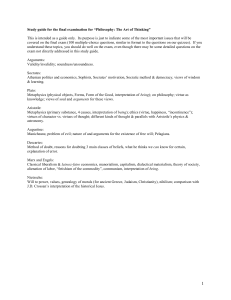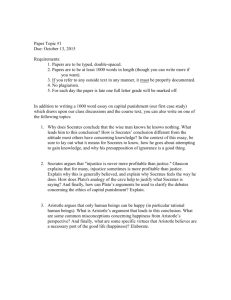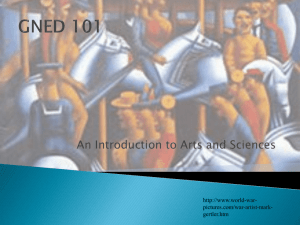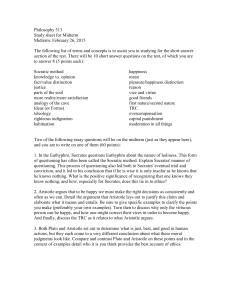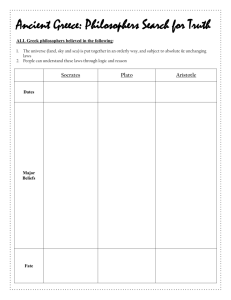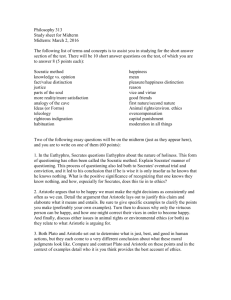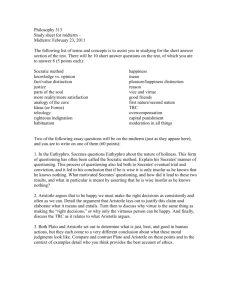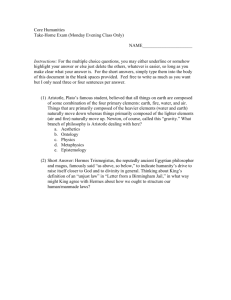24.200: Ancient Philosophy Prof. Sally Haslanger November 1, 2004 Categories
advertisement
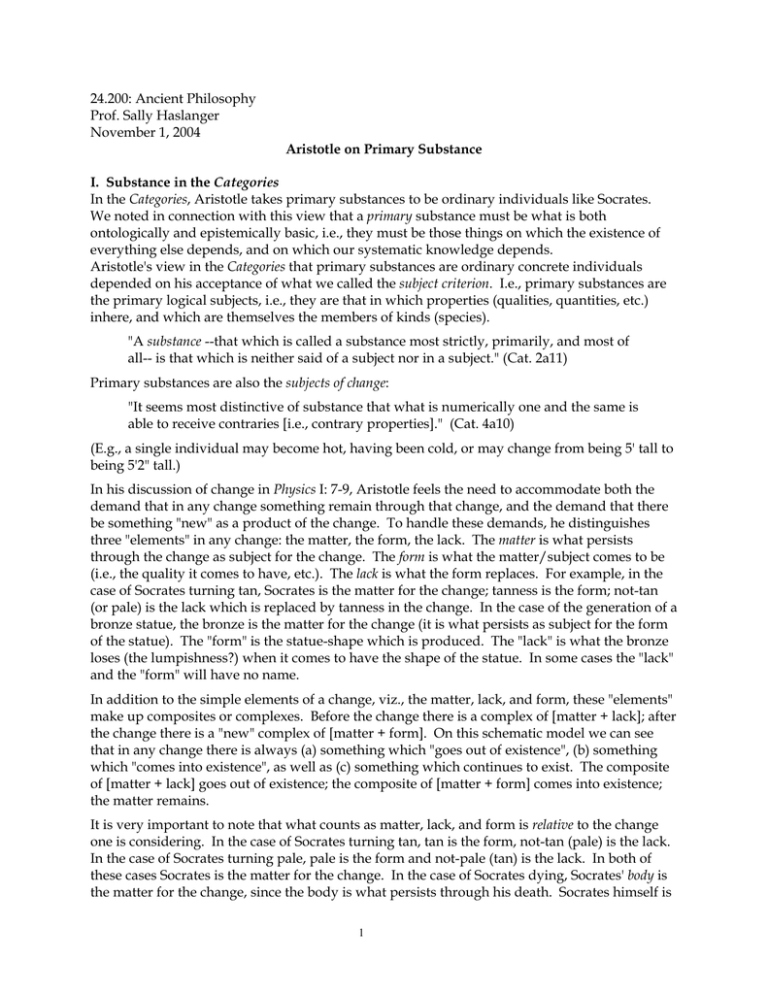
24.200: Ancient Philosophy Prof. Sally Haslanger November 1, 2004 Aristotle on Primary Substance I. Substance in the Categories In the Categories, Aristotle takes primary substances to be ordinary individuals like Socrates. We noted in connection with this view that a primary substance must be what is both ontologically and epistemically basic, i.e., they must be those things on which the existence of everything else depends, and on which our systematic knowledge depends. Aristotle's view in the Categories that primary substances are ordinary concrete individuals depended on his acceptance of what we called the subject criterion. I.e., primary substances are the primary logical subjects, i.e., they are that in which properties (qualities, quantities, etc.) inhere, and which are themselves the members of kinds (species). "A substance --that which is called a substance most strictly, primarily, and most of all-- is that which is neither said of a subject nor in a subject." (Cat. 2a11) Primary substances are also the subjects of change: "It seems most distinctive of substance that what is numerically one and the same is able to receive contraries [i.e., contrary properties]." (Cat. 4a10) (E.g., a single individual may become hot, having been cold, or may change from being 5' tall to being 5'2" tall.) In his discussion of change in Physics I: 7-9, Aristotle feels the need to accommodate both the demand that in any change something remain through that change, and the demand that there be something "new" as a product of the change. To handle these demands, he distinguishes three "elements" in any change: the matter, the form, the lack. The matter is what persists through the change as subject for the change. The form is what the matter/subject comes to be (i.e., the quality it comes to have, etc.). The lack is what the form replaces. For example, in the case of Socrates turning tan, Socrates is the matter for the change; tanness is the form; not-tan (or pale) is the lack which is replaced by tanness in the change. In the case of the generation of a bronze statue, the bronze is the matter for the change (it is what persists as subject for the form of the statue). The "form" is the statue-shape which is produced. The "lack" is what the bronze loses (the lumpishness?) when it comes to have the shape of the statue. In some cases the "lack" and the "form" will have no name. In addition to the simple elements of a change, viz., the matter, lack, and form, these "elements" make up composites or complexes. Before the change there is a complex of [matter + lack]; after the change there is a "new" complex of [matter + form]. On this schematic model we can see that in any change there is always (a) something which "goes out of existence", (b) something which "comes into existence", as well as (c) something which continues to exist. The composite of [matter + lack] goes out of existence; the composite of [matter + form] comes into existence; the matter remains. It is very important to note that what counts as matter, lack, and form is relative to the change one is considering. In the case of Socrates turning tan, tan is the form, not-tan (pale) is the lack. In the case of Socrates turning pale, pale is the form and not-pale (tan) is the lack. In both of these cases Socrates is the matter for the change. In the case of Socrates dying, Socrates' body is the matter for the change, since the body is what persists through his death. Socrates himself is 1 the composite of body and soul which gives way to a new composite, the corpse. (Presumably the form present in the corpse has no name). Within this general model of change, we can distinguish two kinds of change: alteration, and generation/destruction. Intuitively, when an object alters, the object which changes continues to exist while gaining or losing a property (think of Socrates becoming tan). In contrast, when an object is destroyed, it doesn't merely lose a property, it goes out of existence altogether (think of Socrates dying). We can accommodate this intuitive contrast within Aristotle's account by noting that alterations are cases in which the "matter" for the change is an individual substance, and the "lack" and "form" are merely qualities, quantities, etc., of the substance. I.e., alterations are changes in an object's accidental properties. In the case of generation and destruction, we are considering a composite thing prior to the change, which is replaced by a new composite, i.e., the original [matter + lack] ceases to exist and is replaced by a new [matter + form]. An individual substance such as Socrates will be generated just in case the "form" of the new composite is a substantial form, e.g., the essence or nature of human being (which is human soul). An individual substance will be destroyed just in case the "lack" which is lost is a substantial form. So when Socrates dies, the body ceases to be informed by the soul, and Socrates (the composite of body and soul) ceases to exist. II. Four causes In Physics II: 3, Aristotle introduces the doctrine of four "causes" or explanatory factors. A "cause" answers a "why?" question. Aristotle claims that there are four basic types of "why?" question, and corresponding to these there are four basic types of cause. The four causes are: FINAL CAUSE: (goal, end, aim, function, telos): Why does he walk? To stay fit. FORMAL CAUSE: (essence, structure, form, arrangement): Why is this body alive? Because it has a soul (the soul being the form of the body). Why does the ball roll? Because it is a sphere. MATERIAL CAUSE: (constituent, that of which something is composed, or from which (as substratum) it comes to be): Why is this statue green? Because it is made of copper. EFFICIENT CAUSE: (the primary source of change/motion and rest): Why is he fit? Because he walks. Notice that in the examples given above, fitness is the final cause of walking (i.e., it is the goal or aim of walking) and walking is the efficient cause of fitness (walking is what causes the bodily changes that constitute fitness). Aristotle also believes that in many cases the final and formal causes coincide: the (ideal) form of human being is both that which makes humans what they are, and is the goal of human development. The doctrine of the four causes applies best to biological objects. In the case of explaining biological objects (their natural states, behavior, activities, development), one can typically give all four causes. This is connected to Aristotle's idea of a biological object for he believes that such objects should be understood as sets of material components (ultimately, earth, air, fire and water) that are structured or formed in such a way as to move towards self-determined goals. This is true, for example, of human beings. Given that human beings are made up of matter, there will sometimes be questions about us that must be answered in terms of the kind of material to which humans are composed, e.g., a human body will fall through the air to the surface of the earth because it contains a great deal of earth. So if I were to fall out of a window, my falling would have to be explained in terms of my material components. Yet, earth, air, fire, and water, are not of such a nature that by 2 themselves they would shape up into human beings. The simple mechanical principles governing these elements can in no way explain how it is, or why, masses of material get shaped up into living organisms. In order to explain this, Aristotle believes that we need a new level of explanation, i.e., FORMAL explanation. It is the form which is responsible for the particular materials shaping themselves into a living organism. Further, many of the things humans do can be explained only by the fact that they are human. For instance, I am capable of making moral choices and contemplating truth. This is something that cannot explained by pointing out that I'm made of certain material components; one must turn to considerations such as what kind of thing I am, e.g., my form. III. Substance in the Metaphysics Now that we have introduced the form/matter account of change, should we continue to say that individuals such as Socrates are primary substances? What is the subject of change, i.e., that which persists while gaining and losing properties? What is that in which properties inhere? In Metaphysics VII:3, Aristotle argues that if we insist that primary substance is just what meets the subject criterion, then we are forced to say that matter is primary substance. As we saw, the subject which continues to exist through Socrates' death is Socrates' body; but also, what continues to exist through the decomposition of Socrates' body will be (ultimately) the earth, air, fire, and water, of which his body is composed. And if water can give way to air (e.g., in evaporation), then we should postulate something even more basic as the matter for such elemental change. But Aristotle is concerned that such basic material stuff can't properly play the role of primary substance. Why not? To put Aristotle's answer simply, matter can't be what is ontologically and epistemologically basic. This partly depends on his view of science: on his account systematic knowledge rests on knowledge of definitions, and strictly speaking, it is only form that can be defined. Even if we try to define matter, what we are capturing is the structure or form of the matter. Moreover, when consider what it is for something to exist, we find that any thing must have a form. Unformed matter is nothing; any natural thing is a composite of matter plus substantial form. (Consider Aristotle's doctrine of "four causes". Remember that the form of an object will serve as its efficient, final, and formal cause; so the form will be responsible for the object's generation as well as its natural changes and activities.) In keeping with these demands on primary substance, Aristotle articulates explicitly two further criteria for primary substance which must be considered in addition to the subject criterion. (See Metaphysics VII:1-3, especially 1028a8-15 and 1029a27-29). (I have supposed that these were in some sense implicit even when he was writing the Categories.) (a) A primary substance is what a thing is (think of an answer to Socrates' "What is X?" question); they are the primary objects of knowledge, and being so, they are objects of definition and the ultimate explanatory factors. And: (b) A primary substance is an individual and separable "this". Primary substance is what is responsible for the unity and integrity of individual beings of the world. Given the considerations of the Categories and the Physics, the best candidates for primary substance are matter, form, and the composite of matter and form. As I suggested above, 3 (prime) matter cannot be primary substance for it is neither (a) what a thing is, i.e., that which is the primary object of knowledge and definition, nor is it (b) a particular "this", i.e., a something, a real being. Perhaps, then, the composite of matter and form is primary substance. But this is impossible, for the elements of the composite surely are more basic (in both senses) than the composite. The composite cannot be a primary object of knowledge because to know a composite one must know its elements; and the composite cannot be ontologically basic since the existence of the composite depends on the existence of its elements (and not vice versa). So primary substance cannot be (prime) matter, or the composite of matter and form. As a result, Aristotle argues that primary substance is SUBSTANTIAL FORM, i.e., the form (or essence, or nature) of particular substances such as Socrates. That is to say, in the composite of matter and form which constitutes Socrates, it is the formal component which is the primary substance. This formal component is his essence. To know what Socrates is, is to know his (definable) essence; and the existence of Socrates depends upon the existence of his essence. Thus Aristotle has revised his views between the time he wrote the Categories and the time he wrote the Metaphysics on what counts as primary substance. By the time of the Metaphysics, he no longer takes the subject criterion to be the true test of primary substance, but comes to see that other factors must be emphasized in order to determine what is ontologically and epistemologically basic. His change of mind was motivated by his recognition of (i) the fact that ordinary concrete individuals are composites of matter and form, and (ii) the fact that definition, and so definable objects, are required for scientific knowledge. Because substantial forms (or essences) are the proper objects of scientific knowledge, and because the substantial form is the cause of a natural object's unity and integrity, he ultimately decides that substantial forms, and not concrete individuals, are ontologically and epistemologically basic. 4
